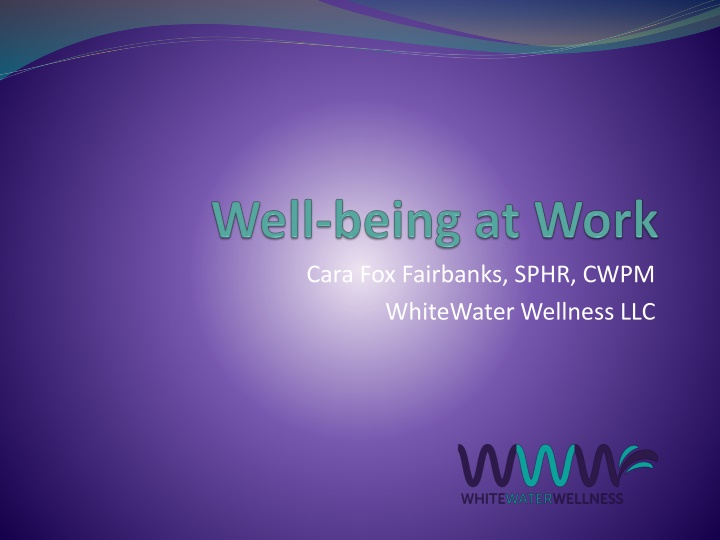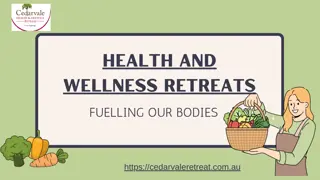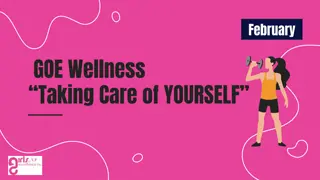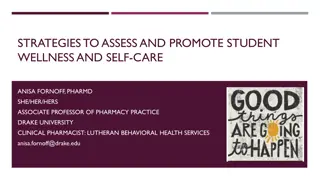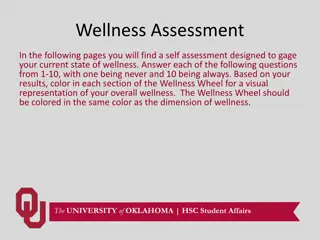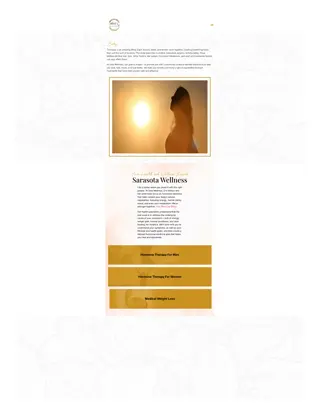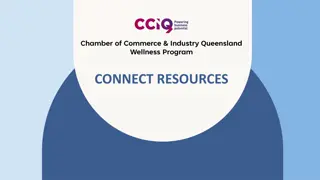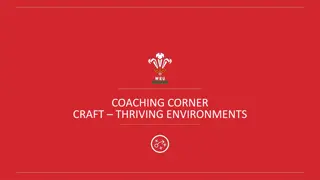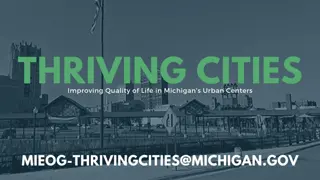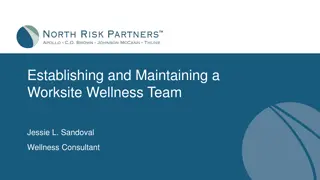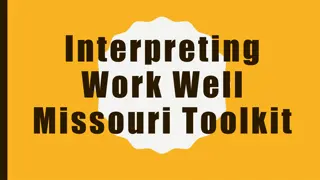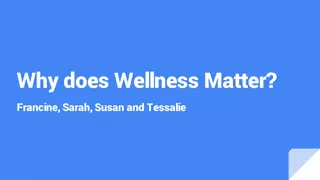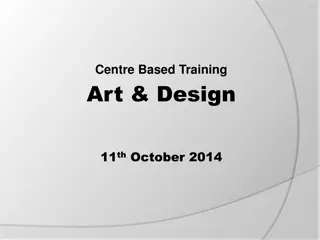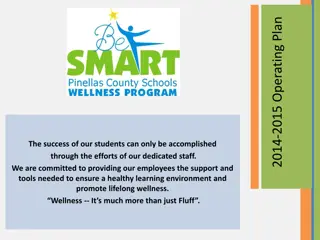Wellness Insights: Art and Science of Thriving
Wellness encompasses a holistic approach to health, focusing on five key elements of well-being to achieve optimal health and happiness. Discover the importance of career well-being, social connections, financial security, physical health, and community involvement in enhancing overall wellness. Learn how personal well-being impacts individuals and explore the journey towards thriving in all aspects of life.
Download Presentation

Please find below an Image/Link to download the presentation.
The content on the website is provided AS IS for your information and personal use only. It may not be sold, licensed, or shared on other websites without obtaining consent from the author.If you encounter any issues during the download, it is possible that the publisher has removed the file from their server.
You are allowed to download the files provided on this website for personal or commercial use, subject to the condition that they are used lawfully. All files are the property of their respective owners.
The content on the website is provided AS IS for your information and personal use only. It may not be sold, licensed, or shared on other websites without obtaining consent from the author.
E N D
Presentation Transcript
Cara Fox Fairbanks, SPHR, CWPM WhiteWater Wellness LLC
How We Talk about it Wellness = Absence of illness/disease Wellness = Minimal risk of disease This comes from a focus on disease management Results in a limited, narrow view of wellness Clinical thinking is critical in sick care but only part of the picture in wellness.
What is it to YOU? What makes YOU thrive?
Wellness is the art and science of getting people to practice healthy habits [regardless of their health status].
Five Elements of Well-Being 1. Career well-being 2. Social well-being 3. Financial well-being 4. Physical well-being 5. Community well-being Well-being is about the combination of our love for what we do each day, the quality of our relationships, the security of our finances, the vibrancy of our physical health, and the pride we take in what we have contributed to our communities. It s about how these five elements interact. - Well Being by Tom Rath, Jim Harter
66% of people are doing well in at least one of these areas 7% are thriving in all five Biggest threat to wellbeing = ourselves Career wellbeing: most essential of the 5 Do you like what you do each day? Boosts your chances of reaching wellbeing in other areas
How are we doing? As of 2014... Ranked #1 Source: Gallup Healthways Well-Being Index 2014, state ranking out of 50, city ranking out of 189
Our score fluctuates Alaska Well Being Rank Year Element Rank 2014 1 Purpose 1 2013 16 Social 7 2012 31 Financial 2 2011 4 Community 3 2010 4 Physical 2 2009 5 2008 11
Alaskas Health Stats (CDC) 2001 2006 2011 or 2012 2013 or 2014 41% 38% 38% 37% 39% 30% 38% 30% 29% 34% 26% 23% 29% 22% 25% 26% 24% 20% 19% 21% 22% 26% 22% 21% 8% 8% 6% 4% Smokers Overweight Obese Sedentary High High BP Diabetes Cholesterol Source: CDC Behavioral Risk Factor Surveillance System Data
Health Risks Increase Health Costs Depressed 70% Stressed 46% Blood Sugar 35% Obesity 21% Smoker 20% N = 46,000+ X 3years High BP 12% No Exercise 10% 0% 10% 20% 30% 40% 50% 60% 70% Percent Higher Annual Health Plan Costs Source: Goetzel RZ, et al. (1998, October). The relationship between modifiable health risks and health care expenditures: An analysis of the multi- employer HERO health risk and cost database. JOEM, 40(10):843-54
Health Risks Increase Absenteeism Mental Health 150% Back Pain N = 35,451 140% Stressed 131% No Exercise 118% Obesity 116% 0% 50% 100% 150% Percent Higher Absenteesim Source: Serxner, S., et al., (2001). The impact of behavioral health risks on worker absenteeism. JOEM, 43(4), 347-354.
Health Risks Increase Workers Comp Costs Low Overall Wellness Score 1989% Smoking 1243% N = 3,388 X 4 years Poor Health 836% No Exercise 556% Low Life Satisfaction 255% 0% 500% 1000% 1500% 2000% Percent Higher Annual WC Costs Source: Musich, S., et. al., (2001, June). The Association of Health Risks with Workers Compensation Costs, JOEM, P. 534-541
Sedentary Culture Americans sit 11 hours a day Muscles are inactive 70-80% of our waking hours Burn 51,000 calories less per year than 50 years ago 1 in 10 adults have trouble walking a distance equal to walking from the parking lot to the back of a large store or through a mall.
Your Body on Prolonged Sitting Less oxygen to brain Inhibited learning, concentration, motivation Slower metabolism of fat and cholesterol Fat burning enzymes shut down after a couple hours Circulation slows, increased fatigue, sore muscles/joints Higher rates of diabetes and heart disease More likely to die (from all causes) Regardless of other exercise!!!
Consequences of Current Culture: $ Health Benefits $ Sick Leave = $ Workers Comp $ STD & LTD (Disability) $ FMLA $ Presenteeism $ Morale/Turnover $ Loyalty $ Productivity $ Accuracy $ Quality of work and life
Key Ingredients for Success Management support (top down) Employee support (bottom up) Goals & objectives Strategy & plan Measurement Feedback (both ways) Cultural Support Management Support Employee Support
Program Components & Variations Participation Focus General Focus Disease management Health & well-being Morale (fun, team-building) Work-life balance Individualized Group-based Voluntary Involuntary Participant Experience Scope of Program Passive Active & empowered Comprehensive Campaign-based or issue-based
Level of Integration Delivery Among wellness plan components With company policies & practices With health plan On-site Online Other technology (i.e. mobile devices) Off-site Combination Source Private vendor Insurance company One or multiple public sources In-house
Incentives Group based Individual Competition Money or financial Tangible or intangible Carrot vs. Stick Integration with health plan Entry fee concept Loss aversion
The Incentive Debate They CAN (and DO) change behavior But does it last? Which is better, the carrot or the stick? Do incentives kill intrinsic motivation? Some incentives are not so obvious Be thoughtful & cautious in design of incentives
An incentive will get someone to try something new, but people have to see someone they know and trust doing that behavior before they are willing to make a permanent change.
Legal & Compliance Considerations Regulating bodies: IRS, DOL, HHS (Potential) Applicable laws and regulations: ERISA: HIPAA, COBRA GINA: Genetic Information Nondiscrimination Act ACA (Affordable Care Act) IRC: taxation of incentives ADA (Americans with Disabilities Act) Civil Rights Act of 1964 (Title VII) State laws Is your wellness program part of or linked to a group health plan? i.e. discounted premiums based on health factors
Do you have to follow ACA rules? Participatory Plans Health Contingent Plans Rewards based on participation only, no health factors Offered to all similarly situated individuals Rewards based on meeting a standard related to a health factor Two categories: Activity-Only Outcome-Based BOTH MUST MEET THE REQUIREMENTS OUTLINED IN THE REGULATIONS (But they differ slightly) DOES NOT HAVE TO MEET THESE REQUIREMENTS
Realistic Expectations (Range) Low High Participation 5%-25% 65%-95% <$50 Annual Cost Per Employee $250+ 2.5:1 to 6.5:1 <1:1 ROI When evaluating programs, ask how is participation measured? Consider administration time in cost ROI is tricky to measure
Measuring Success How you measure your success depends largely on your goals & objectives Why bother? Refine and improve your program going forward Justify the use of resources Get employees excited about participation Potential measures and metrics: Business Performance Individual success stories Claims costs, other associated costs Turnover Change in Personal Health Assessment scores Disability claims Employee satisfaction surveys can look at many Safety incidents variables Participation Use of sick days (absenteeism) Workers comp claims Number of employees who smoke Cultural norms Employee engagement
What shapes our behaviors: People Spaces Head Space Systems Motivation Capability Inertial Force Barriers Motivation + Capability > Barriers + Inertial forces
Where to Start? Define your purpose, budget, and approach Designate a wellness team or person Look at past efforts what s worked, what hasn t? Take stock of current policies/facilities do they promote or inhibit healthy practices Get familiar with your employees Demographics Related metrics Particular interests Define your goals and objectives
Back to the 5 Elements Career Well Being Supportive management Growth opportunities Appreciation Strong communication Social Well Being Encourage social networks at work & outside of work Financial Well Being Financial education Retirement planning Fair/Competetive Pay Physical Well Being Movement at work Support healthy eating Worksite wellness programs Prevention focused health plan Flexible scheduling Community Well Being Volunteer opportunities & group outings Company support of community initiatives
How to Move More at Work Standing work stations Walking work stations Biking work stations Walk vs. email/phone Walking meetings Gym meetings Take a break every hour Support alternative commuting Park farther away
Are YOU a Wellness Leader? Walk the talk Be a wellness ally Find supporters Build support Make it a part of your business strategic plan, mission, vision, etc.
Most people spend their years sacrificing their health to gain their wealth, only later to spend their wealth reclaiming their health.
Resources Welcoa: www.welcoa.com Centers for Disease Control (CDC): www.cdc.gov/nccdphp/dnpao/hwi/index.htm National Wellness Institute (NWI): www.nationalwellness.org LinkedIn Groups State of Alaska: www.hss.state.ak.us/dph/chronic/worksite/default.htm HERO Scorecard: http://hero-health.org/scorecard/
Make a comparison chart Compare the things that are really important to you Modify as you learn more Have vendor give presentation See it in action
Questions? cara@whitewaterwellness.com 907-223-4883
